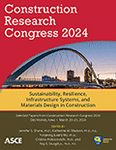Case Study: Effect of the Condition Data of Automated Pavement Surveys on Pavement Performance Indicators
Publication: Construction Research Congress 2024
ABSTRACT
State departments of transportation (DOTs) have been transitioning from manual to automated pavement condition surveys with the advantages such as safe and speedy data collection and consistency and repeatability in data collected. The manual and automated data collection methods have inherently different capabilities for measuring pavement distress. When state DOTs use pavement performance indicators developed based on manually collected data and have already introduced an automated data collection process, the different capabilities can be problematic by either overestimating or underestimating actual pavement conditions. This study investigated the effect of the condition data of automated pavement surveys on a manual-based pavement performance indicator through a case study. The case study was a structural cracking index (SCI) used for the West Virginia Division of Highways. This study investigated the effect of automated pavement condition surveys on manual-based pavement performance indicators. The study found that automated surveys can lead to changes in distress data compared to manual inspections, suggesting non-random change patterns. These changes can lead to significant budget losses for state agencies. The study also demonstrated the applicability of the approach used for a case study for other state agencies to evaluate their current pavement performance indexes.
Get full access to this article
View all available purchase options and get full access to this chapter.
REFERENCES
Attoh-Okine, N., and Adarkwa, O. 2013. Pavement Condition Surveys – Overview of Current Practices. Delaware Center for Transportation, University of Delaware: Newark, DE.
FHWA. 2015. “Pavement comparative analysis technical report: Comprehensive truck size and weight limits study – Chapter 4: Scenario impacts.” FHWA Freight Management and Operations, <https://ops.fhwa.dot.gov/freight/sw/map21tswstudy/technical_rpts/pcanalysis/04_scen_impacts.htm≥ (May 13, 2023).
FHWA. 2022. “Highway statistics 2020.” FHWA Policy and Governmental Affairs, Office of Highway Policy Information, <https://www.fhwa.dot.gov/policyinformation/statistics/2020/>(May 13, 2023).
Jia, X., Huang, B., Dong, Q., Zhu, D., and Maxwell, J. 2016. “Influence of pavement condition data variability on network-level maintenance decision.” Transportation Research Record, 2589(1), 20–31.
Luo, X., Gong, H., Tao, J., Wang, F., Minifie, J., and Qiu, X. 2022. “Improving data quality of automated pavement condition data collection: Summary of state of the practices of transportation agencies and views of professionals.” Journal of Transportation Engineering, Part B: Pavements, 148(3), 04022042.
McQueen, J. M., and Timm, D. H. 2005. “Statistical analysis of automated versus manual pavement condition surveys.” Transportation Research Record, 1940(1), 54–62.
The Kercher Group. 2021. “Performance audit of the Ohio Department of Transportation.” Ohio DOT, <https://ohioauditor.gov/performance/odot_project/Kercher_ODOT_Pavement_Evaluation.pdf.AccessedJuly11,2022>(May 10, 2023).
Pierce, L. M., and Weitzel, N. D. 2019. Automated Pavement Condition Surveys., Transportation Research Board, Washington, DC.
Saliminejad, S., and Gharaibeh, N. G. 2013. “Impact of error in pavement condition data on the output of network-level pavement management systems.” Transportation Research Record, 2366(1), 110–119.
Sami, N. 1997. Composite Condition Index for West Virginia DOT. IMS Infrastructure Management Services Inc., Tempe, AZ.
Serigos, P. A., Prozzi, J. A., de Fortier Smit, A., and Murphy, M. R. 2016. “Evaluation of 3D automated systems for the measurement of pavement surface cracking.” Journal of Transportation Engineering, 142(6), 05016003.
Tao, J., Luo, X., Qiu, X., and Wang, F. 2021. “Data quality assessment of automated pavement cracking measurements in Mississippi.” International Journal of Pavement Research and Technology, 14, 117–128.
Tighe, S. L., Ningyuan, L., and Kazmierowski, T. 2008. “Evaluation of semi-automated and automated pavement distress collection for network-level pavement management.” Transportation Research Record, 2084(1), 11–17.
Timm, D. H., and McQueen, J. M. 2004. A Study of Manual vs Automated Pavement Condition Surveys. Highway Research Center, Auburn University, Auburn, AL.
Vavrik, W., Evans, L., and Stefanski, J. 2013. PCR Evaluation - Considering Transition from Manual to Semi-automated Pavement Distress Collection and Analysis. FHWA, Washington, DC.
WVDOH. 2019. “Transportation asset management plan.” <https://transportation.wv.gov/highways/programplanning/Documents/2019-Final-TAMP.pdf>(May 10, 2023).
Information & Authors
Information
Published In
History
Published online: Mar 18, 2024
Authors
Metrics & Citations
Metrics
Citations
Download citation
If you have the appropriate software installed, you can download article citation data to the citation manager of your choice. Simply select your manager software from the list below and click Download.
